Did you know: Traditional landscapes can consume up to 50% more water than sustainable low-maintenance landscaping solutions? Not only are you able to save time, money, and resources by making the switch, but you’ll also enjoy a beautiful outdoor space that boosts curb appeal and improves local environmental health. Curious how you can transform your yard (or even your business property) into an eco-friendly, easy-care retreat? Unlock the latest secrets and sustainable landscaping ideas for outdoor spaces that practically take care of themselves.
Why Sustainable Low-Maintenance Landscaping Is Transforming Modern Outdoor Spaces
Sustainable low-maintenance landscaping is revolutionizing how property owners approach outdoor space. By moving beyond the traditional turf lawn and thirsty annuals, homeowners and businesses are discovering how landscaping ideas rooted in native plants and eco-friendly materials can create outdoor living environments that require less effort and yield more lasting benefits. This shift supports not only water conservation but also enhances curb appeal, boosts biodiversity, and cuts down on costly maintenance tasks that consume valuable time and resources.
Driven by climate change and the need to conserve water, sustainable landscaping offers much more than just a new look. Incorporating native plant species, permeable pavers, and natural mulch cuts down dramatically on irrigation needs and reduces stormwater runoff. Smart irrigation systems add even more efficiency, ensuring that every square foot of your garden is cared for without unnecessary waste. As a result, sustainable gardens are beautiful, functional, and future-ready—an essential evolution for modern outdoor spaces seeking lasting value.
Whether your goal is to create a sustainable landscape in a residential backyard or to enhance the outdoor areas of commercial properties, the benefits are clear. Not only will you enjoy a thriving garden design that works with nature, but you’ll also support wildlife, increase property value, and strengthen your community’s environmental resilience—all while spending less time and money on ongoing upkeep.
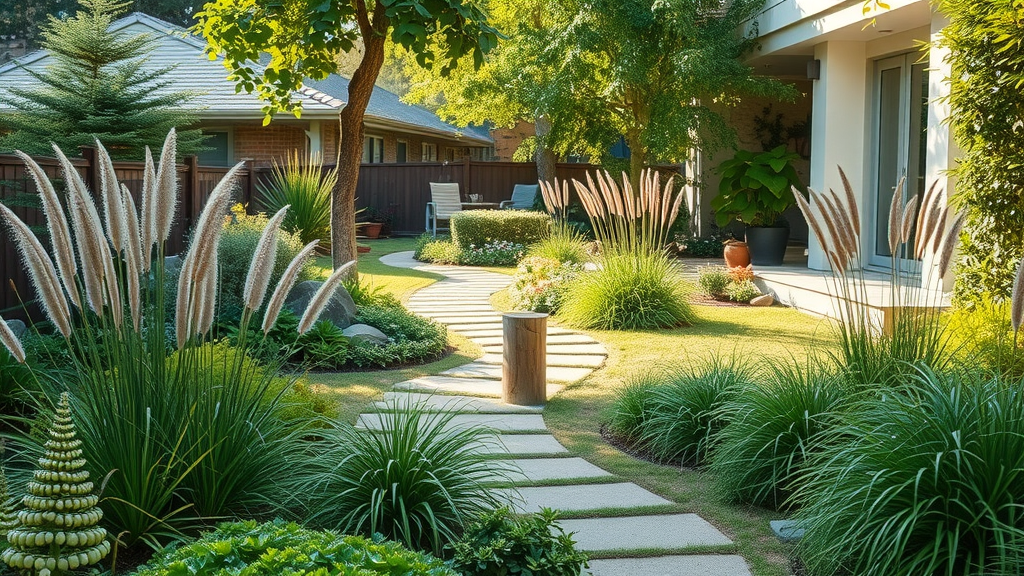
-
Did you know? Traditional landscapes can consume up to 50% more water than sustainable low-maintenance landscaping solutions. Discover how switching now can save you time, money, and resources, while improving curb appeal and environmental health.
Set Your Goals for Sustainable Low-Maintenance Landscaping Success
Before you dive into the latest sustainable landscaping trends, it’s crucial to lay out clear goals for your outdoor space. Start by defining your specific needs: Do you want a private retreat, a playful family zone, or a space for gathering and entertaining? Is curb appeal a top priority, or are you more focused on supporting wildlife and conserving resources across every square foot of your property? Understanding your priorities will guide your garden design from the outset.
Aligning garden design with sustainability and a low-maintenance approach doesn't just mean picking the newest plants or permeable pavers. It’s about making informed decisions that balance your aesthetic desires with real-world considerations like maintenance requirements, water use, and future adaptability. Take time to assess your property’s unique conditions, including sunlight patterns, soil quality, and available water resources; these factors will shape the practical landscaping ideas that will work for your specific site.
-
Defining your outdoor space needs
-
Aligning garden design with sustainability and low-maintenance priorities
-
Assessing your property’s sunlight, soil, and water resources
Unlock the Latest Landscaping Trends for Sustainable, Low-Maintenance Outdoor Living
Every year, sustainable landscaping trends continue to evolve, offering fresh ideas for homeowners and commercial properties alike. Native plants rank among the top landscaping ideas for their resilience, beauty, and ability to support pollinators. Not only do native plantings thrive naturally with local rainfall, but they also minimize the need for chemical pesticides and fertilizers, making them one of the best investments for a sustainable outdoor living space. Ditching the traditional lawn in favor of wildflower meadows, ornamental grasses, or groundcovers further reduces upkeep and ecological impact.
Reclaimed wood and eco-friendly hardscaping also take center stage in today’s sustainable landscaping designs. By repurposing materials—like barn wood for decks and benches or recycled concrete for garden paths—you combine timeless style with environmental responsibility. Smart irrigation and rainwater harvesting are rapidly gaining popularity as well, ensuring your garden or commercial property can thrive even during drought and watering restrictions. These landscaping trends aren’t just for show; they reflect a real commitment to working with nature instead of against it.
-
Native plants for low-water, resilient garden design
-
Reclaimed wood and eco-friendly hardscaping for timeless style
-
Smart irrigation and rainwater harvesting for resource efficiency
“Choosing native plants and sustainable materials is the cornerstone of a beautiful, self-sustaining landscape.” – Leading Sustainable Landscaping Expert
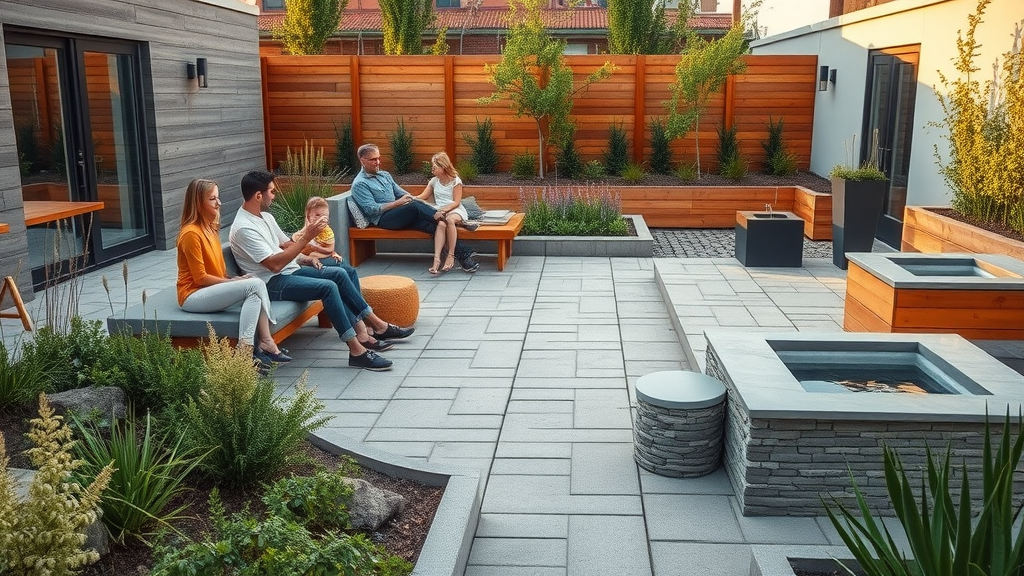
The Best Sustainable Low-Maintenance Landscaping Ideas for Every Outdoor Space
Low-Water Native Plant Selections for Effortless Beauty
Embracing native plants is a smart move for anyone seeking a sustainable, low-maintenance landscape. These species are naturally adapted to your region’s climate and soils, requiring little supplemental water or fertilizer. Popular choices for effortless beauty and pollinator support include lavender, coneflower, yarrow, sedum, and black-eyed Susan . Such plantings help create a biodiverse and thriving ecosystem, reducing your need for pesticides and constant replanting.
Native plants don’t just save water; they bolster the health of your soil, prevent erosion, and create crucial habitat for pollinators and beneficial insects. Replacing sections of turf lawn with a tapestry of native plantings can turn formerly high-maintenance zones into vibrant focal points that change naturally with the seasons. The variety of colors, shapes, and textures available is almost endless, ensuring your sustainable garden never looks bland or uniform.
-
Examples of low-maintenance native plant species
-
How native plants support pollinators and soil health
Reclaimed Wood and Natural Materials: Stylish and Sustainable Choices
Reclaimed wood is taking the landscaping world by storm, providing a sustainable, attractive alternative to newly harvested timber. Sourcing reclaimed wood can be as simple as visiting local salvage yards, woodworking shops, or specialized online retailers. This beautiful material can be used for raised beds, benches, fencing, or even striking garden sculptures. With proper weatherproofing, reclaimed wood lasts for years and gives your outdoor area a unique, eco-conscious character.
Pair reclaimed wood with natural stone and permeable paving for functional and stylish outdoor spaces. Permeable pavers help manage stormwater, reduce runoff, and maintain healthy soil structure beneath paths, patios, and driveways. By choosing materials that work with nature, you’ll achieve a balance of beauty, long-term performance, and sustainability in your garden design.
-
Where to find reclaimed wood for garden design
-
Incorporating natural stone and permeable paving
Smart Irrigation Systems: Efficiency Meets Technology
A smart irrigation system is a game-changer for sustainable low-maintenance landscaping. These systems incorporate weather sensors, soil moisture meters, and programmable zones to deliver water only where and when it’s needed. This targeted approach conserves water and lowers utility bills, making it far more efficient than traditional irrigation setups. Many smart irrigation controllers can be managed straight from your smartphone, giving you ultimate control over your landscape’s needs with minimal effort.
While the upfront cost of smart irrigation can be higher than basic setups, the long-term savings—especially on water bills—quickly offset the investment. As you compare options, factor in local rebates or incentives for water-efficient irrigation systems, which can make these modern solutions even more affordable. Smart irrigation is an essential piece of the sustainable landscaping trends transforming residential and commercial outdoor spaces today.
-
Benefits of a smart irrigation system for lowering water use
-
Cost comparison: traditional vs. smart irrigation
|
Irrigation Type |
Estimated Water Use (per 1,000 sq. ft./year) |
Key Features |
|---|---|---|
|
Traditional Sprinklers |
24,000–30,000 gallons |
Manual programming, high runoff |
|
Drip Irrigation |
12,000–17,000 gallons |
Water at root zone, low evaporation |
|
Smart Irrigation System |
8,000–13,000 gallons |
Weather-based, soil sensors, remote control |
Low-Maintenance Focal Points and Outdoor Features
Creating a visually compelling garden design that stands the test of time means choosing the right focal points. Water features such as simple fountains, birdbaths, or recirculating waterfalls add tranquil sounds and support wildlife—without extensive upkeep. Stylish, durable outdoor furniture crafted from eco-friendly materials or reclaimed wood invites relaxation and enhances your outdoor living space.
Don’t underestimate the power of sculptural plants—think bold grasses, structured evergreens, or eye-catching living walls. These elements serve as year-round focal points and require far less maintenance than traditional flowerbeds, making them perfect for sustainable landscapes of any size.
-
Installing a simple water feature
-
Selecting durable outdoor furniture
-
Sculptural plants and living walls as focal points
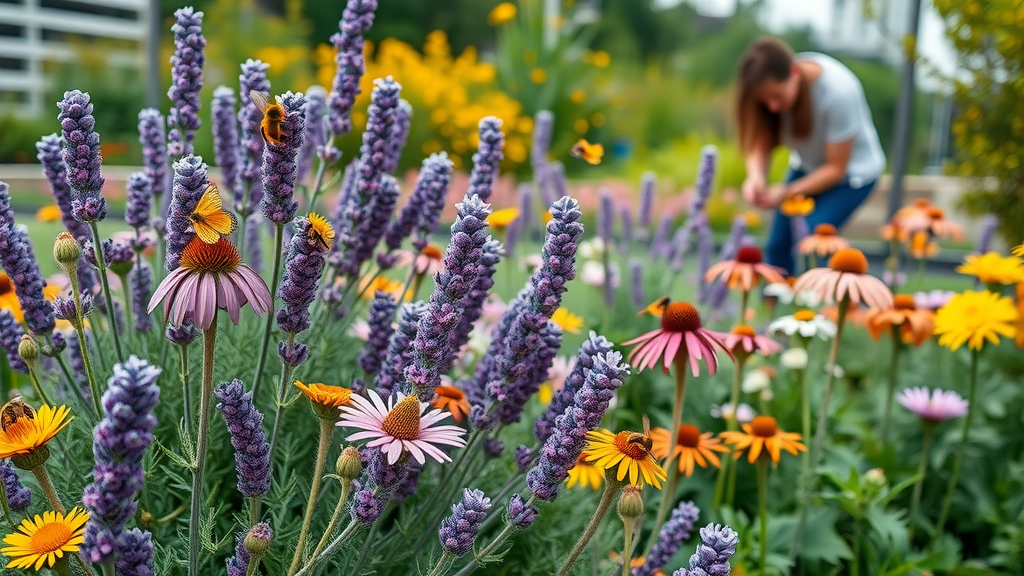
Sustainable Low-Maintenance Landscaping for Commercial Properties: Smart Solutions for Businesses
Commercial properties are increasingly embracing sustainable low-maintenance landscaping to strike a balance between curb appeal and real-world practicality. The right design can highlight your brand’s environmental values, enhance your facility’s appearance, and provide welcoming outdoor spaces for employees and patrons. By incorporating native plantings, permeable pavers, and smart irrigation systems, businesses can significantly cut down on water usage, maintenance costs, and long-term liabilities, turning outdoor areas into assets for years to come.
Aside from environmental stewardship, sustainable landscaping makes financial sense for property owners. Lowered water and maintenance bills, opportunities for LEED certification, and improved stormwater management help commercial properties operate more efficiently. Outdoor living spaces can even serve as informal meeting areas or relaxation zones—improving morale and strengthening your company’s culture from the ground up.
-
Balancing curb appeal with practical maintenance needs
-
Environmental and cost benefits for commercial properties
-
Showcasing outdoor living space for patrons and employees
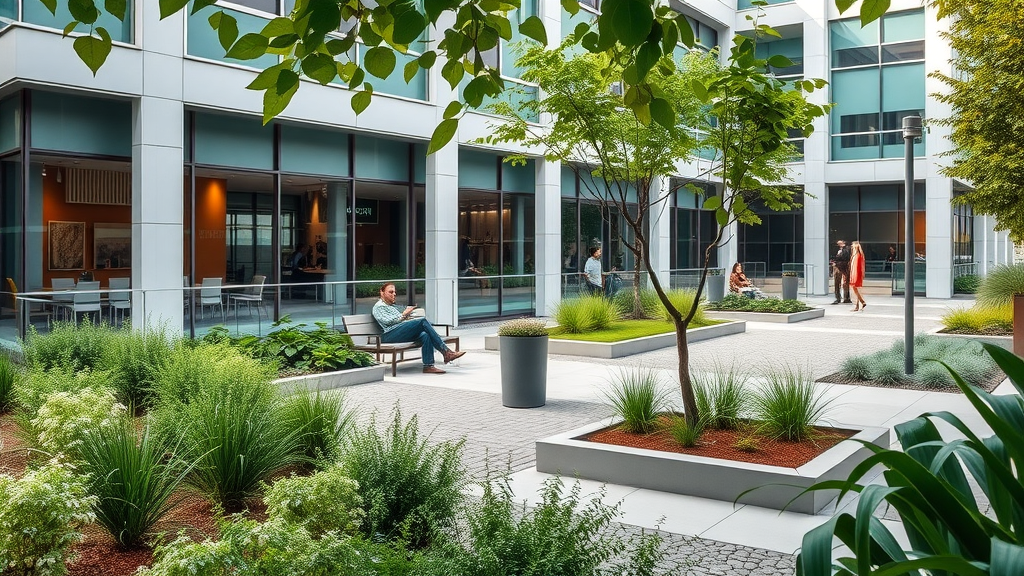
Garden Design Essentials: Ensuring Curb Appeal with Sustainable Low-Maintenance Landscaping
Creating Outdoor Living Spaces for Relaxation and Socializing
Your sustainable landscape should be more than just a pretty backdrop; it can become a true living space for relaxation, socializing, and outdoor living. Blend functional zones—like patios, dining areas, and quiet retreats—with sustainable features such as permeable pavers, native planting beds, and low-energy lighting. By thinking in terms of “rooms” rather than a single open yard, you create inviting spaces to suit every mood and occasion.
Thoughtful outdoor lighting and pathway design ensure safety, highlight accessible routes, and showcase the beauty of your landscape well after sunset. Integrated solar or LED fixtures consume less energy and can be strategically placed to direct attention toward your garden’s best focal points and gathering spots, increasing usability and setting a welcoming mood.
-
Blending functional zones with sustainable elements
-
Outdoor lighting and pathway considerations
Maximizing Focal Points in Your Garden Design
Strategic focal points are the heart of memorable landscaping ideas. Placement of statement pieces—such as boulders, water features, or sculptural plants—anchors your space visually and draws visitors into your sustainable garden. When integrated with low-water native plantings and layered planting beds, these features add drama and interest throughout the seasons with minimal work.
Seamlessly blending bold focal points with your overall garden design results in a natural, harmonious look that spotlights your commitment to both beauty and environmental stewardship. Choose focal points that reflect your style and require little upkeep to ensure your sustainable landscape remains inviting for years to come.
-
Statement pieces: boulders, water features, sculptural plants
-
Seamless integration with native plants
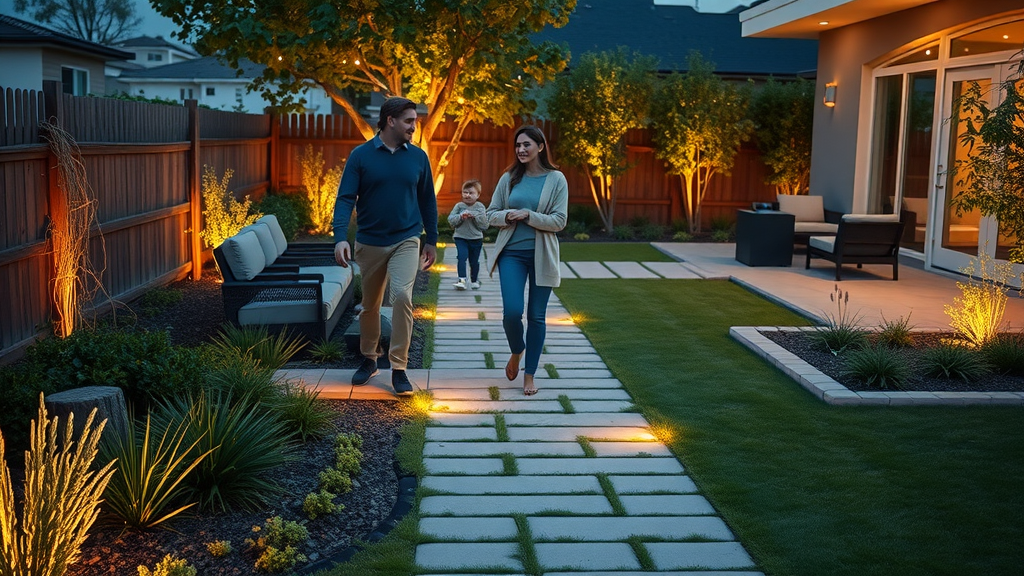
The Role of Smart Irrigation in Sustainable Landscaping Trends
Smart irrigation is at the forefront of today’s sustainable landscaping trends, helping homeowners and property managers conserve water and minimize manual labor. When choosing a smart irrigation system, prioritize models that support weather sensing, soil moisture monitoring, and app-based controls. These features not only cut down on water use but also adjust automatically based on changing weather, so your plants always receive the care they need without waste.
Proper installation and maintenance are critical to maximizing your irrigation system’s performance and lifespan. Work with a licensed landscape professional or seek advice from your local extension office to ensure your smart system is correctly set up and integrated with any rainwater collection solutions. This approach guarantees optimal coverage, prevents overwatering, and supports the healthy growth of your native plantings even during dry spells.
-
Choosing the right smart irrigation system
-
Installation and maintenance tips
-
Integrating irrigation with rainwater collection
How to Maintain Your Sustainable Low-Maintenance Landscaping Year-Round
One of the greatest perks of sustainable low-maintenance landscaping is the reduced time you’ll spend on upkeep. That said, a few simple seasonal tasks will keep your garden design looking its best. In the spring and fall, prune dead growth and refresh mulch around your native plants to retain soil moisture and suppress weeds. Summer calls for monitoring smart irrigation, checking for clogs, and watching for signs of pests—many of which are minimized by diverse native plantings.
To maintain healthy soil and vigorous plants, focus on mulching and composting throughout the year. Using organic mulch and homemade compost improves soil fertility, promotes beneficial microbes, and insulates plant roots. Whenever possible, rely on eco-friendly pest control methods—like encouraging beneficial insects, birds, and using non-toxic remedies—to manage trouble spots and keep your landscape in balance all year long.
-
Seasonal tasks checklist for easy upkeep
-
Mulching and compost for soil health
-
Eco-friendly pest control with native plants
People Also Ask: Sustainable Low-Maintenance Landscaping
What are the best drought-tolerant native plants for sustainable low-maintenance landscaping?
-
Some of the best include lavender, coneflower, yarrow, sedum, and black-eyed Susan. These plants thrive naturally and require minimal intervention.
How can I make my commercial property’s outdoor space more sustainable and easy to maintain?
-
Focus on native and low-water plants, install smart irrigation, use permeable paving, and minimize lawn areas to reduce maintenance and water use.
Which landscaping trends will have the biggest impact in the next decade?
-
Look for an increase in smart technology, native plant emphasis, eco-friendly hardscapes, and creative outdoor living spaces.
Is reclaimed wood suitable for outdoor landscape features?
-
Absolutely. With proper treatment, reclaimed wood is a stylish, durable, and sustainable alternative to new wood for furniture, decking, and raised beds.
Expert Recommendations: Sustainable Low-Maintenance Landscaping for Lasting Curb Appeal
“Sustainable low-maintenance landscaping is not just a trend – it's a lifestyle transformation that future-proofs your home or commercial property.” – Industry Authority
Your Step-by-Step Checklist for Achieving Sustainable Low-Maintenance Landscaping
-
Assess your sun, soil, and water conditions
-
Set clear sustainability and maintenance goals
-
Select native and drought-resistant plants
-
Incorporate reclaimed wood and permeable surfaces
-
Install smart irrigation systems
-
Regularly revise and adapt your landscape as it matures
Common Myths About Sustainable Low-Maintenance Landscaping – Debunked
-
Myth: Eco-friendly landscaping is more expensive
-
Myth: Native gardens are messy and unattractive
-
Myth: Sustainable solutions are only for large outdoor spaces
Frequently Asked Questions on Sustainable Low-Maintenance Landscaping
-
How do I start planning my transition to a sustainable, low-maintenance yard?
Start with an assessment of your site conditions—sun, soil, and water—then research native plants and sustainable materials. Set clear goals, sketch your layout, and consult local experts for help with design and installation. -
Can sustainable landscaping increase property value?
Yes. Sustainable gardens boost curb appeal, reduce operating costs, and appeal to buyers seeking eco-friendly features—often increasing both residential and commercial property values. -
What routine maintenance is actually required?
Most sustainable landscapes need seasonal mulching, some pruning, occasional weeding, and periodic checks of your irrigation system. Native plants reduce the need for heavy maintenance compared to traditional lawns. -
How do smart irrigation systems reduce water bills?
Smart irrigation systems use weather data and soil sensors to deliver water only when necessary, preventing waste and lowering monthly water expenses.
Ready to Transform Your Space? Start Your Sustainable Low-Maintenance Landscaping Journey Today!

-
Explore recommended service providers, DIY resources, and expert consultations to design your dream low-maintenance outdoor living space.
Take the first step today – redefine your outdoor space with sustainable low-maintenance landscaping solutions tailored for lasting curb appeal, reduced maintenance, and a healthier environment!
 Add Row
Add Row  Add
Add 


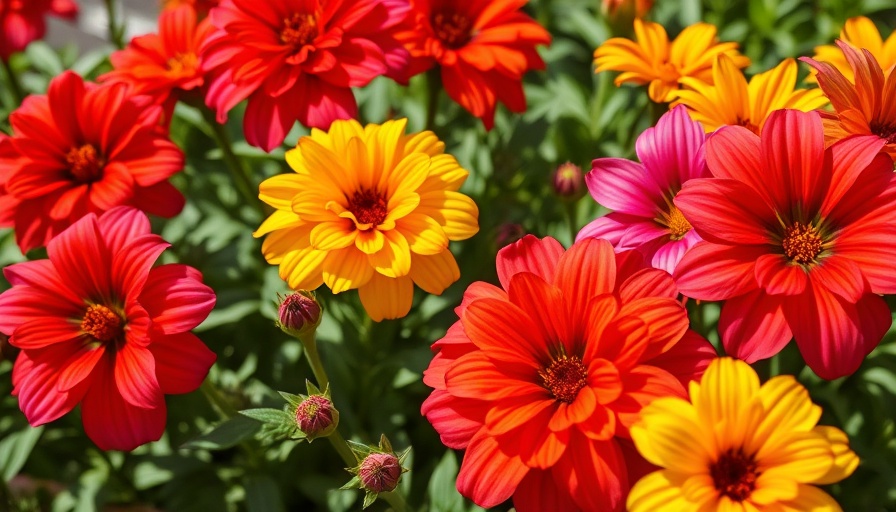

Write A Comment